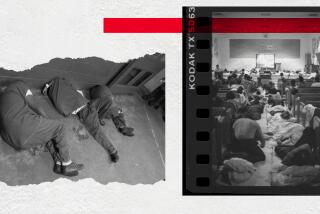Empty Jail Fails to Fill Expectations
- Share via
BONNE TERRE, Mo. — A half-century past its prime as one of the nation’s top lead-mining towns, the rural community of Bonne Terre envisioned newfound prosperity when it was chosen as home for the state’s largest and costliest prison.
The hills were made low, the valleys raised and a dozen underground springs diverted to transform a hay pasture into a prison the size of 50 square city blocks.
But today, six years after the grand announcement that the prison would be built here, the $168-million facility has no inmates and no opening date. The city is in debt, and new businesses that hoped to serve the prison’s work force are near broke.
Lawsuits and construction delays have pushed the completion date from 1998 to the end of August. But even then, the prison will remain closed because the state cannot afford the $12 million needed to equip it or the nearly $45 million required annually to run it.
The boom that has turned to bust in Bonne Terre is part of an expansion, begun in the mid-1990s, that will nearly double the capacity of the Missouri Department of Corrections.
Missouri, along with many other states, began building prisons to accommodate an influx of inmates caught under tougher sentencing laws. At the same time, communities that once might have shunned prisons began competing for the economic benefits they could bring.
Now, as the economy weakens, some states are adjusting their plans. In North Carolina, for example, a legislative subcommittee recently recommended that the state drop one of three planned prisons because of a lack of money.
Competing with several cities in the mid-1990s, Bonne Terre agreed to purchase the land for a state prison and issued bonds to help pay for $14 million in improvements--a project nearly 10 times the size of its annual budget.
“We put in sewer lines and water lines and built roads, and business leaders in the community all geared up to either expand their businesses or open up,” said city manager Jeffrey Jeude.
“Now we’re paying back the loans on these improvements and we don’t have any increase in revenues to do that,” he said.
Businesses are in a similar bind.
In January 2000, Jayne Bess opened a 40-room Super 8 Motel down the road from the prison, counting on inmate visitors and prison suppliers to fill the rooms. After one year of business, Bess was fortunate to fill even one-third of the motel.
“A lot of business people had high hopes,” Bess said. “We’re very disappointed.”
Businesses that didn’t build early are now taking a wait-and-see approach.
Howard Wood leads a firm that bought 240 acres near the prison, clearing fruit trees to create sites for new homes and businesses. So far, only a bank has committed to the location. And it hasn’t begun building.
“We’re just one of a multitude of businesses who were dependent upon the prison going ahead and opening,” Wood said. He estimated that local businesses have lost millions of dollars, perhaps even tens of millions.
Businesses didn’t think they were taking a gamble when the $168-million prison (the figure includes interest on borrowing) was announced in 1995. The sheer size of the project inspired optimism:
* 20 buildings.
* A huge kitchen to prepare meals for 30,000 inmates across eastern Missouri.
* 2,684 inmates--enough to boost Bonne Terre’s population by two-thirds.
(And, although the state kept this quiet for a time, there would also be a death chamber.)
“It’s the largest, single-site construction facility ever undertaken by the state of Missouri,” said Jim Bray, the prison’s construction manager.
The prison opening would have been the best economic news for Bonne Terre since the St. Joseph Lead Co. stopped digging in the area in 1961.
In the early part of the 19th century, the Bonne Terre area was considered the lead-mining capital of the United States. Miners constructed more than 300 miles of underground railroad tracks to bring thousands of tons of lead to the surface each year.
St. Joe Lead, as locals called it, helped build Bonne Terre’s hospital, library, golf course, public water system and First Congregational Church, and ran several farms and stores.
Today, many of Bonne Terre’s 4,039 residents work elsewhere, commuting to neighboring towns or 60 miles northeast to St. Louis, said Larry Hughes, Bonne Terre’s economic development director.
The largest employer in Bonne Terre is the school district, followed by a nursing home. Yet put together, their 550 employees don’t match the work force of 819 guards, medical professionals, maintenance workers and administrators that would be required to staff the prison.
They won’t be hired any time soon.
Faced with a budget shortfall of $300 million, Missouri Gov. Bob Holden ordered most agencies to make immediate cuts earlier this year and to trim their spending requests for the fiscal year starting July 1 by an additional $300 million.
The Department of Corrections has left hundreds of guard positions vacant at operating prisons and decided to delay the opening not only of the Bonne Terre prison but also another new one in Charleston. The smaller Charleston prison, with a $20 million operating cost, now is expected to open by spring 2002, said department spokesman Tim Kniest.
The earliest the Bonne Terre prison could receive funding is July 2002, and even then it could be several months before it would open.
More to Read
Sign up for Essential California
The most important California stories and recommendations in your inbox every morning.
You may occasionally receive promotional content from the Los Angeles Times.









